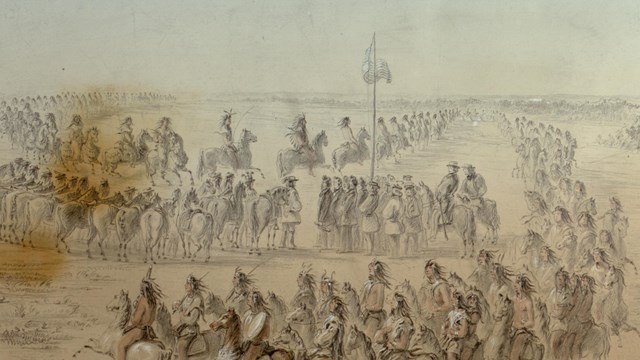Nez Perce War
Introduction
Text-to-speech Audio
The Bears Paw Mountains on the right in the distance are the site of the Bears Paw Battlefield, the location of the final battle of the Nez Perce War of 18 77, one of the last Indian wars in the American West. The events that took place in 1877 can be remembered as the Nez Perce people's painful and tragic encounter with 'Manifest Destiny'.
Images
Treaty Grounds

Backstory and Context
Text-to-speech Audio
Picture this: Your family has owned the property where you live for many generations. The highway department comes and tells you that a new project requires your land, but that you will receive replacement property, less than half the size, in a different location. Soon afterward, the highway department reduces your new property by another 90% in size and orders you to move immediately. This is the situation that several bands of Nez Perce Indians in Idaho, Eastern Washington and Eastern Oregon faced in the spring of 18 77. After enduring over 20 years of injustice, indignity and unlawful trespass, the Indians were in the process of moving to a new reservation in Idaho far from their home in the Wallowa Mountains in north eastern Oregon. While on the way, several young braves confronted longstanding white antagonists and killed them, touching off what was to become known as the Nez Perce War. Chiefs Joseph, White Bird and Looking Glass led nearly 800 Nez Perce on a four month, 1,170 mile odyssey through the Northwest toward sanctuary in Canada. Pursued by over 2,000 US cavalry under the command of General Oliver Howard, the Nez Perce were finally caught in the Bear’s Paw Mountains by a contingent of 400 troops led by Colonel Nelson Miles. Miles laid siege to the Indians on Snake Creek and after four days was joined by General Howard on October 4, 1877. That very night, with Chief Joseph’s blessing, White Bird and some 200 Nez Perce escaped the siege and made their way to safety in Canada. On the morning of October 5, the 418 Nez Perce who remained at the Bear Paw Battlefield surrendered to Colonel Miles. They were led by Chief Joseph, who offered perhaps one of the most eloquent surrender speeches in recorded history. As translated by interpreter Arthur Chapman, Chief Joseph said: “Tell General Howard I know his heart. What he told me before – I have it in my heart. I am tired of fighting. Too-hul-hul-sit is dead. Looking Glass is dead. He-who-led-the-young-men-in-battle is dead. The chiefs are all dead. It is the young men now who say ‘yes’ or ‘no’. My little daughter has run away upon the prairie. I do not know where to find her – perhaps I shall find her too among the dead. It is cold and we have no fire; no blankets. Our little children are crying for food but we have none to give. Hear me, my Chiefs! From where the sun now stands, Joseph will fight no more forever.” At the time of the surrender at Bear Paws, Colonel Miles promised Chief Joseph that the captured Nez Perce would be allowed to go to the reservation in Idaho. Congress overruled that promise and sent the captured Nez Perce to Indian Territory in Oklahoma where many died of disease. Subsequently, both General Howard and Colonel Miles became advocates for better treatment of the Nez Perce. Eventually, Joseph and the remaining tribal members were moved to northeastern Washington. They were never allowed to return to either their former home or the Nez Perce reservation in Idaho.
Sources
The flight of 1877 - Nez Perce National Historical Park (U.S. National Park Service). (n.d.). https://www.nps.gov/nepe/learn/historyculture/1877.htm
Empire Builder Master Resource Guide 20170702, Klondike Gold Rush National Historical Park – Seattle Unit, National Park Service/Department of the Interior
https://www.nps.gov/nepe/learn/historyculture/1877.htm
